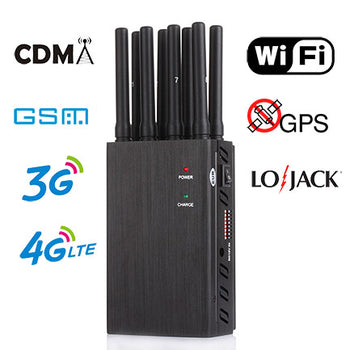How does the mobile phone signal jammer realize the working principle of signal shielding?
1. How does the mobile phone signal jammer realize the working principle of signal shielding?
Mobile phone jammer is generally composed of power supply, electronic scanning control unit, segmented radio frequency module unit, amplifier unit, transmitting antenna unit and other parts. Its working principle is generally generated by a sawtooth wave signal generator. After the inverter is inverted, it enters the voltage-controlled oscillator to modulate the mobile communication working frequency band, and then is amplified by a power amplifier and a voltage regulator tube to control the power. The radio frequency signal is transmitted into the air in the form of radio waves.
The working principle of mobile communication is that within a certain frequency range, the mobile phone and the base station are connected by radio waves to complete the transmission of data and sound with a certain baud rate and modulation method. When the mobile phone communicates, it contacts the base station through the uplink frequency, and then transfers the signal to the MSC mobile service switching center to realize the call. In the standby state, the mobile phone communicates with the base station through the BCH broadcast control channel. Once there is a need for a call, it first asks the MSC for instructions through the BCH. call on the channel. The mobile phone signal jammer scans from the low-end frequency of the forward channel to the high-end frequency at a certain speed during the working process according to the above principle. The scanning speed can cause garbled interference in the message signal received by the mobile phone, and the mobile phone cannot detect the normal data sent from the base station, so that the mobile phone cannot establish a connection with the base station.

Second, the use of mobile phone jammers and interference analysis
At present, there are many types of jammers on the market, with different transmission power, interference frequency band, and coverage. In particular, some "three-no" products have rough workmanship, poor emission indicators, and the radio frequency unit has no segment control, and the uplink and downlink frequencies are interfered together. After the actual testing and understanding of the technical indicators of various mobile phone jammers, jammers can be divided into three categories according to the technical indicators. ;The other type is a low-power multi-channel mobile phone jammer, the single-unit transmit power is 5-10 watts, the transmit power of each channel is 1-5 watts, and the shielding range is several meters to tens of meters; the third type is high-power or ultra-high-power jammers, It is generally dedicated to special industries, such as public security and judicial shielding devices, with power ranging from tens of watts to hundreds of tens of watts, both single-channel and multi-channel.
In order to realize the interference of the mobile phone signal jammer to the mobile network, it must be ensured that the signal field strength sent by the jammer is far greater than the field strength of the mobile signal BCH in the interference area. The closer the interference location is to the base station, the stronger the BCH field strength, and the effective interference area. On the contrary, the farther the interference location is from the base station, the weaker the BCH field strength and the larger the effective interference area. It can be seen that within a certain transmission power, the interference range depends on the BCH field strength in the interference area. No matter how powerful the shield is, as long as the transmission power is a fixed value, as the distance increases, the interference signal strength will gradually attenuate, thus Loss of jamming capability, which means that the jammer always has an effective jamming range. But in the case of jammer interference handled in recent years, it is often the case that a large area of interference is caused when the jammer is used. What is the reason?
It is said that jammers always have an effective interference range, which is for jammers that only interfere with the downlink frequency band of mobile communications, but not suitable for jammers that interfere with both the uplink and downlink frequency bands. The interference of the uplink signal directly causes the deterioration of the signal-to-noise ratio of the mobile base station system and the deterioration of the communication quality. That is to say, how many base stations around the interfered area are affected by the uplink jammer will cause the area covered by these base stations to interfere, thus forming a large area of interference. Below is a brief analysis of the reasons for the GSM system: (omitted)
In the process of connection, handover and conversation, the system establishes and maintains the smoothness of the voice channel through SD, FACCH and SACCH signaling respectively. If the interference is too large and the bit error rate is too high, the decision of the signaling message will be affected, and the system will not be able to parse the signaling normally, and the erroneous signaling will be discarded. This is what we often call dropped calls. Therefore, in the user's calling phase, if the interference is too large, it will lead to failure to connect and affect the wireless connection rate index; during the user's call, if the interference is too large, it will lead to dropped calls, affecting the success rate of system handover and call drop rate. index. At the same time, during the call, the interference affects the voice channel, and the bit error rate increases, which will lead to poor voice quality, noise, intermittent, single-pass and other phenomena. The statistical indicators show that the training bit error rate is high and the MOS value is reduced.













